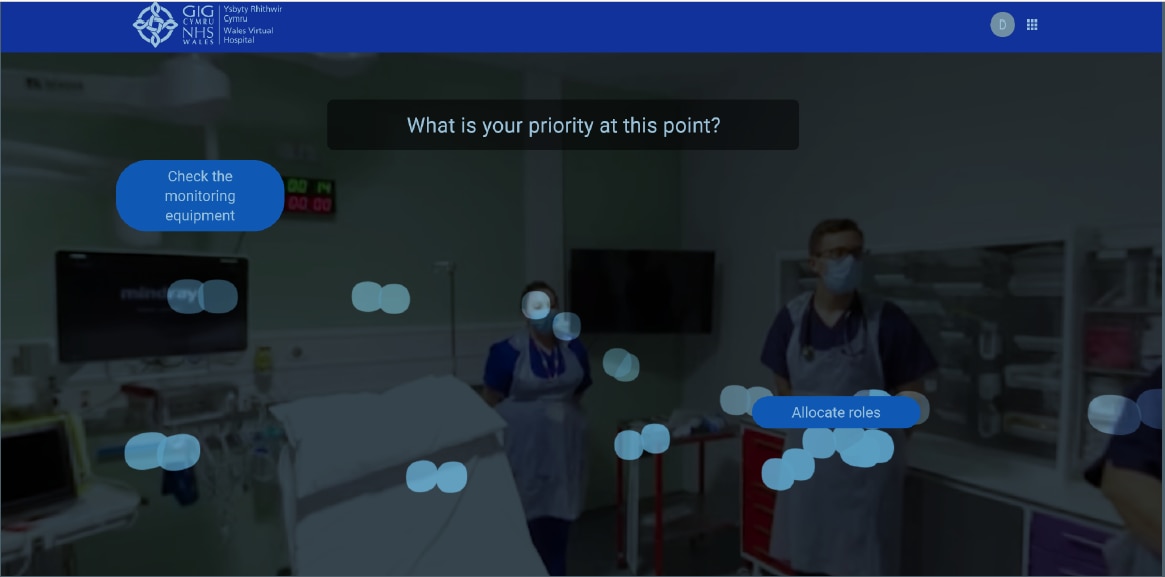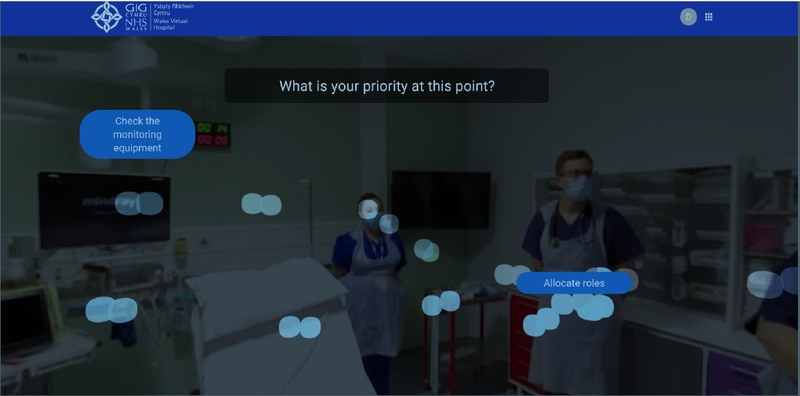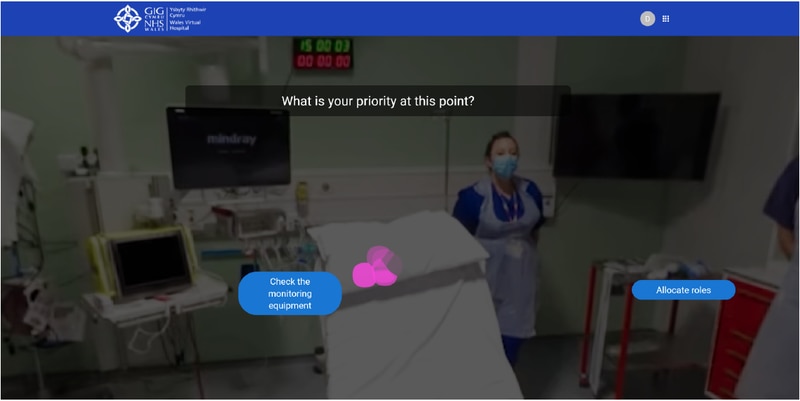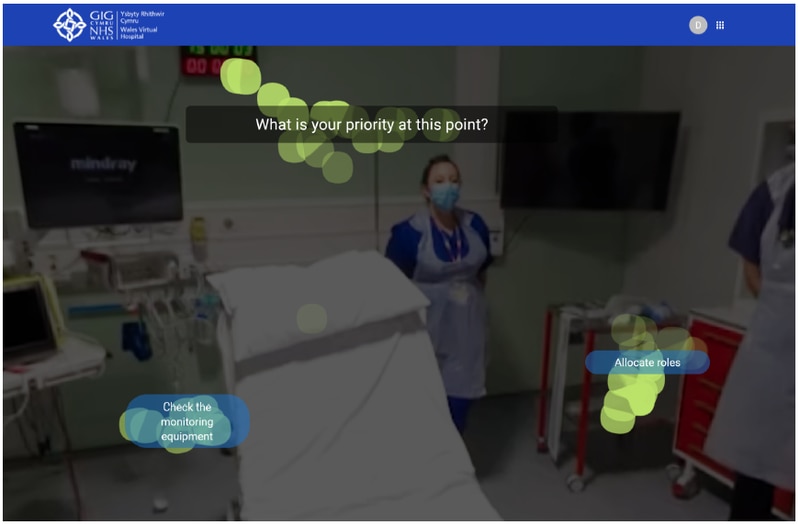<< Back to Stories

Virtus Tech and Wales Virtual Hospital - the importance of Eye Tracking

Healthcare | Public Safety | Training/Simulation | Article
5 minutes read
Wales Virtual Hospital is an immersive training adjunct for learning from
traditional in-person clinical placement/activity and simulation. It was
created as part of the project founded by the accelerator programme. It
allows learners to practise, develop and improve their existing
decision-making skills in commonly presenting clinical scenarios in a safe
virtual environment, however, it also acts as a training/assessment tool for
high acuity.
The platform aims to help healthcare learners to feel better prepared for
future clinical situations and to make immersive simulated learning
experiences more widely available and accessible.
Medical VR training
VR is a relatively new frontier of medical training that is becoming more
and more popular. It’s a great tool for clinicians to learn in a safe place
where they can fail and start again, it gives highly immersive simulation,
can be customised and is affordable.
It’s highly important to review medical training to see how end-users are
interacting with the system to make sure they continue to improve. Data
capturing tool is something VR training can’t be completed without.
“There is tremendous potential in Wales’ Virtual Hospital in diversifying
the learning opportunities we can offer healthcare workers and students
across the country. The platform provides simple, effective, and accessible
immersive VR learning to all of NHS Wales. This adjunct to simulation and
clinical education focuses on clinical decision making and other
non-technical skills. Online access across Wales makes it so easy to
standardise teaching and training … whilst, the fact scenarios can be
shared between healthcare teaching staff and adjusted, makes it easy to
ensure we can also tailor the learning experience for different groups of
learners.”
- Dr Kosta Morley, South Wales Major Trauma Network Education Lead
Importance of data capturing in VR medical training
VR gives a great access to user data because of the headsets’ tracking
capabilities. This data then can be exported to an analytics tool and
demonstrate training effectiveness while showing areas of improvement.
This can help to improve end-users' experience dramatically, which means
that scenarios are not just being created and deployed, but also being
constantly updated and improved.
At Wales Virtual Hospital data capturing plays a crucial role as it allows all
course clinicians to see how well users have performed while in virtual
reality assessments. With such technology medical professionals can get a
greater access to their training results, as they can review their
performance and be given the chance to retry.
Software Center of attention tracking technology method
In the past we used Software Center of attention tracking technology
methods that shows the results of the user’s centre of gaze. This means
that we could track where users are looking, while helping clinicians to get
more information about decisions that users were about to make.
This method doesn’t require any extra hardware and can be used across all
of the different devices that are supported: Computer, mobile, any headset.
Using this data we can replay scenarios back to clinicians and users in real
time to increase the review process;
The issue was that when users looked straight ahead, but their eyes were
moving around, we would not be able to capture where they were really
looking, only if they moved their head.
However, by adding an eye tracking to the system users experience can be
greatly improved.

The eye tracking data method
The new eye tracking data method gives a better insight of where the
users are looking at. Unlike software center of gase tracking methods, now
we can track the actual eye movement and see if the users are looking
around even if they don’t move their head. As seen in the image below,
with software only tracking, if the user does not turn their head, you
cannot see where they are looking.

However, when the new eye tracking device was implemented the fidelity
of the tracking increased, thus the accuracy of the data. From this data
users can see when learners are making a decision, looking between two
different answers. Data can be captured with regards to how many times
they refer to the question, and look back at each answer. A data capture
that was not possible with the software only tracking system.

A real life example of how eye tracking method can improve scenario:
An average duration of a user's answer is 20 seconds, however, one answer
takes approximately 45 seconds to answer. Thanks to the eye tracking
method we could tell that this difference occurred because all of the
answers were straight ahead and one of them was in the back. Therefore, it
took users longer to find it.
So, if with the software center of gase method we could only see the
direction users are looking, with the eye tracking system we can see two
different answers they are deciding between. Therefore, by using this new
system clinicians get more information when they are reviewing the user
using the system.
This eye tracking data can also be used to improve the usability of the
application, user experience and user flow of the application. As part of this
project we’ve been working with ATiC enabling us to improve the
application.
“Data capture enables teachers and training staff to provide more
in-depth, personalised feedback which is a cruitcal part of learning
process. The eye tracking data gives further detail that has not been
possible in the past.”
- Dr Kosta Morley, South Wales Major Trauma Network Education Lead
Conclusion
Both eye tracking methods are a great tool to make VR training more
effective by giving the healthcare professionals more in-depth information
on how they performed while in training. The hardware eye tracking
system takes the tracking data to the next level within our software. It is
very easy to use and integrate into new systems, all around being a brilliant
add-on to a headset.
traditional in-person clinical placement/activity and simulation. It was
created as part of the project founded by the accelerator programme. It
allows learners to practise, develop and improve their existing
decision-making skills in commonly presenting clinical scenarios in a safe
virtual environment, however, it also acts as a training/assessment tool for
high acuity.
The platform aims to help healthcare learners to feel better prepared for
future clinical situations and to make immersive simulated learning
experiences more widely available and accessible.
Medical VR training
VR is a relatively new frontier of medical training that is becoming more
and more popular. It’s a great tool for clinicians to learn in a safe place
where they can fail and start again, it gives highly immersive simulation,
can be customised and is affordable.
It’s highly important to review medical training to see how end-users are
interacting with the system to make sure they continue to improve. Data
capturing tool is something VR training can’t be completed without.
“There is tremendous potential in Wales’ Virtual Hospital in diversifying
the learning opportunities we can offer healthcare workers and students
across the country. The platform provides simple, effective, and accessible
immersive VR learning to all of NHS Wales. This adjunct to simulation and
clinical education focuses on clinical decision making and other
non-technical skills. Online access across Wales makes it so easy to
standardise teaching and training … whilst, the fact scenarios can be
shared between healthcare teaching staff and adjusted, makes it easy to
ensure we can also tailor the learning experience for different groups of
learners.”
- Dr Kosta Morley, South Wales Major Trauma Network Education Lead
Importance of data capturing in VR medical training
VR gives a great access to user data because of the headsets’ tracking
capabilities. This data then can be exported to an analytics tool and
demonstrate training effectiveness while showing areas of improvement.
This can help to improve end-users' experience dramatically, which means
that scenarios are not just being created and deployed, but also being
constantly updated and improved.
At Wales Virtual Hospital data capturing plays a crucial role as it allows all
course clinicians to see how well users have performed while in virtual
reality assessments. With such technology medical professionals can get a
greater access to their training results, as they can review their
performance and be given the chance to retry.
Software Center of attention tracking technology method
In the past we used Software Center of attention tracking technology
methods that shows the results of the user’s centre of gaze. This means
that we could track where users are looking, while helping clinicians to get
more information about decisions that users were about to make.
This method doesn’t require any extra hardware and can be used across all
of the different devices that are supported: Computer, mobile, any headset.
Using this data we can replay scenarios back to clinicians and users in real
time to increase the review process;
The issue was that when users looked straight ahead, but their eyes were
moving around, we would not be able to capture where they were really
looking, only if they moved their head.
However, by adding an eye tracking to the system users experience can be
greatly improved.

The eye tracking data method
The new eye tracking data method gives a better insight of where the
users are looking at. Unlike software center of gase tracking methods, now
we can track the actual eye movement and see if the users are looking
around even if they don’t move their head. As seen in the image below,
with software only tracking, if the user does not turn their head, you
cannot see where they are looking.

However, when the new eye tracking device was implemented the fidelity
of the tracking increased, thus the accuracy of the data. From this data
users can see when learners are making a decision, looking between two
different answers. Data can be captured with regards to how many times
they refer to the question, and look back at each answer. A data capture
that was not possible with the software only tracking system.

A real life example of how eye tracking method can improve scenario:
An average duration of a user's answer is 20 seconds, however, one answer
takes approximately 45 seconds to answer. Thanks to the eye tracking
method we could tell that this difference occurred because all of the
answers were straight ahead and one of them was in the back. Therefore, it
took users longer to find it.
So, if with the software center of gase method we could only see the
direction users are looking, with the eye tracking system we can see two
different answers they are deciding between. Therefore, by using this new
system clinicians get more information when they are reviewing the user
using the system.
This eye tracking data can also be used to improve the usability of the
application, user experience and user flow of the application. As part of this
project we’ve been working with ATiC enabling us to improve the
application.
“Data capture enables teachers and training staff to provide more
in-depth, personalised feedback which is a cruitcal part of learning
process. The eye tracking data gives further detail that has not been
possible in the past.”
- Dr Kosta Morley, South Wales Major Trauma Network Education Lead
Conclusion
Both eye tracking methods are a great tool to make VR training more
effective by giving the healthcare professionals more in-depth information
on how they performed while in training. The hardware eye tracking
system takes the tracking data to the next level within our software. It is
very easy to use and integrate into new systems, all around being a brilliant
add-on to a headset.